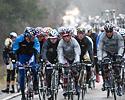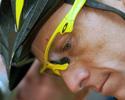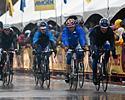
Recently on Cyclingnews.com |
Tour of California News, February 16, 2009Edited by Les Clarke & Gregor Brown Mancebo reignited after 2006 Operación Puerto linkBy Kirsten Robbins in Santa Rosa, California
Francisco 'Paco' Mancebo took his first major victory since he retired from the professional racing with the French-based AG2R team in 2006. His Tour of California stage one solo victory Sunday marked the biggest win for his USA-based team Rock Racing. According to the Spaniard, the pressure of being linked to Operación Puerto in 2006 forced him to take a step back from professional racing and coming stateside has reignited his passion for the sport. "There was too much pressure on me during that time because of the Tour de France," said Mancebo, who does not think that the re-opened Operación Puerto investigation will affect him. "I feel like I have less pressure now. I enjoy the sport more now than I did before because there's a lot less stress and I am having more fun racing now." Mancebo was one of the top stage race contenders in the world after his consecutive podium finishes in the 2004 and 2005 Vuelta a España. He placed sixth in the 2004 Tour de France and fourth in the 2005 Tour de France. Investigations linked him to Operación Puerto as code number 17 in 2006 while he racing for the France-based team AG2R and he left that year's Tour de France just prior to the start along with riders like Ivan Basso and Jan Ullrich. "My team would not let me leave the Tour that year, so I left on my own." He did not re-sign with AG2R the following season. He spent one year with Relax-GAM and one with Fercase - Rota dos Móveis. Michael Ball brought him into the Rock Racing team after winning the Mexico's Vuelta a Chihuahua. Mancebo noted that joining a team with friends like Oscar Sevilla and Enrique Gutiérrez was appealing to him.
Cyclingnews will cover the 60th edition of
the Dauphiné Libéré live
as of stage 4 on Wednesday, June 10, at approximately 15:00 local Europe
time (CEST)/ 23:00 Australian time (CDT)/ 9:00 (USA East). "I've raced since I was eight years old on a bike," Mancebo said. "After riding for so long, I felt like I was just doing it because I had to. I just kind of lost interest in it. I took a step back and now I totally enjoy it." Mancebo has no intention of competing in Europe again. Leipheimer still in contentionBy Mark Zalewski in Santa Rosa, California
Two-time Tour of California winner Levi Leipheimer (Astana) had a tough ride into his hometown of Santa Rosa, compared to the previous three times the race has finished here. Firstly it was cold and raining. But more of a concern was the fact that Francisco Mancebo was up the road and the team had little information on his time gap. Eventually the team rallied enough to keep Mancebo's lead in check, should it hold into Friday's time trial. "I think I can, I hope I can," Leipheimer said in relation to his chances for the overall after today. "Mancebo is obviously strong and a great rider. Hats off to him today. But we can be happy with the damage we corrected at the end there." Leipheimer said that if they had more information, and earlier, that the chasing would probably have been different. "We would have had guys chasing before that climb in the middle and been a little more urgent about it. In the end he rode fantastic and hopefully we saved the day." It was certainly all hands on deck for the Astana team, as Lance Armstrong was driving the train onto the finish circuits to pull the time back. "Lance was fantastic," said Leipheimer. "In the end it was a team time trial and he was pulling with the guys. He asked if he wanted to pull harder and I told him I needed him for the end. He was a great teammate." The decision by the officials and race organisation to take the GC time on the first lap of the finishing circuit means that Leipheimer is now 1:07 down on Mancebo, along with seventeen other riders. When asked how today's conditions compared to last year's epic stage into San Luis Obispo, he said. "Not that cold, and we had some intensity today, so that always helps!" Bad luck hands Landis a different leashBy Mark Zalewski in Santa Rosa, California
An untimely puncture during a vital moment in the Tour of California's first stage may have cost Floyd Landis (OUCH-Maxxis) a chance at an overall podium placing. The inaugural Tour of California champion was in perfect position to keep himself in contention for an overall win, making it into the main chase group during the cold and rainy ride to Santa Rosa, with two key teammates, Rory Sutherland and Pat McCarty. He suffered the flat tyre on the descent of the final KOM towards the finish in Santa Rosa, and although McCarty sacrificed his bike for his leader, the damage was already done; Landis finished almost five minutes behind stage winner Francisco Mancebo. "He got a flat at the worst time," teammate Tim Johnson told Cyclingnews. "We had three guys in the group of 20, with Rory and Pat there too. And to have them in that group with Grand Tour winners... it was a star-studded group. But after that last KOM when the s**t was hitting the fan, he got a flat. Pat gave up his bike but he wasn't able to catch. We just had Rory in the group but it was totally disastrous!" With Landis 4:54 down on the other GC contenders, the sole responsibility will fall on the defending NRC champion Rory Sutherland. We would love to get Floyd back in but one in the GC is what we have. A lot of teams lost their GC guys today, but this also allows us to race more aggressively." said Johnson, adding that being down on time will allow Floyd more of a leash in terms of breakaway attempts. "For Floyd it just handed him what he wants! Life tougher out of retirement for ArmstrongBy Mark Zalewski in Santa Rosa, California
"Tough day!" is how Lance Armstrong (Astana) described Sunday's rain-soaked road stage at the Tour of California, his first road race on US soil since retiring from professional racing nearly four years ago. "I was thinking that a year ago I was in St. Barts on a beach!" "I was cold today," he said frankly. "That was one of the hardest days I've had to do. My hands were good, but my feet were not!" After race leader Fabian Cancellara (Saxo Bank) pulled out of the event, the golden jersey was up for grabs and Astana shouldered a lot of the responsibility to chase breakaway rider Francisco Mancebo (Rock Racing). Due to communication issues however, the chasing started too little, too late. "Obviously if you don't catch somebody you can always say you should have started earlier," said Armstrong. "But it worked out alright. I think for the [time trial] Levi can take that back. The tough guys were still with us – Zabriskie, Michael Rogers... [it was a] hard day." Armstrong also had a scare on the wet roads, when Carlos Sastre (Cervélo TestTeam) crashed and hit his rear wheel, causing it to flat. Then, during the chase later in the stage, it was like being back in the old days, with directeur sportif Johan Bruyneel yelling into the team's radio. "Horner, he killed us! He killed us up the hill and then down was a hard day," Armstrong explained. "We were still going hard downhill. Then in the end it was full-on team time trial, with Johan yelling at us!" Unorthodox finish to California stageBy Mark Zalewski in Santa Rosa, California
The finish of the first road stage of the Tour of California was up in the air for about four hours after the conclusion of the race, with officials working long after the riders crossed the line to figure out placings and time. The reason was that officials and the race organiser made an on-the-road decision to separate the finish of the stage in terms of general classification and stage, due to the harsh weather. The rain-soaked finish in Santa Rosa posed a sprinting threat, and as such there was worry about the effects a crash could have on GC contenders. This was a direct reaction to the race two years ago when a crash on the same finish circuits jeopardized then race-leader Levi Leipheimer's GC chances. The official communiqué from the race said, "Due to safety concerns, the extreme nature of the weather, and the technical nature of the circuit the decision was made on the road to take the GC times on the first passage of the finish line and the remaining laps were for raced stage placings. No time bonuses were awarded." However, due to the communication issues on the road during the stage there was some question as to whether all teams knew of the decision. Astana's Johan Bruyneel said he was uncertain what the final decision was. The race's technical director Chuck Hodge told Cyclingnews that the decision was made early in the stage and that any announcement was made only discussion by the officials was finished, in order to ensure equity among all the teams. Foul weather grounds race communication planeBy Kirsten Robbins in Santa Rosa, California The Tour of California stage one communication fell apart when bad weather conditions prevented a fixed-wing aircraft carrying race communications tools from taking off. According to Jim Birrell, the race technical director, not having the necessary equipment kept ties between the technical directors and the race directors down for the majority of the 173-kilometre road race. "The weather played into a lot of the decision we had to make today," said Birrell regarding the official decision to call the race as the first rider, Mancebo, entered onto the first circuit. "The fixed wing aircraft couldn't leave the airport because there was ice at 4000 feet. All of our repeater units were in that fixed wing aircraft. Birrell normally has the ability to communicate with the race officials, race caravan and technical directors between the start and the finish line of every stage. However, due to the problems communication shifted to mobile phones. "It helps to prepare for when the riders come into town. When there is a long break away those riders on one side of a mountain and the field on the other side of the mountain, I can't talk through that mountain on a simplex radio. The second thing is that it has the repeaters for videos. We didn't see most of the race today because the fixed wing was on the ground." The event also had two helicopters carrying video equipment. However, the helicopters only capacity to fly for two hours before refuelling and can only fly up to 1000 feet. At one point the stage one break away had gained twelve minutes on the field. As the leaders descended one side of the mountain, the peloton was more than five miles behind on the other side of the mountain, preventing the officials from communicating accurate time splits to the to the teams. Birrell made the decision to stop the GC time on the competing riders as they entered the finishing circuits. "If you recall, in 2007 we had a pretty bad crash here at the finish line," Birrell said. "We made the decision, for the safety of the riders." Previous News Next News (All rights reserved/Copyright Future Publishing (Overseas) Limited 2009) |





